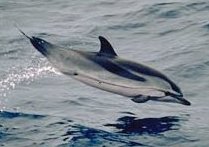Stenella
| Stenella Temporal range:
| |
|---|---|

| |
| Striped dolphin | |
| Scientific classification | |
| Domain: | Eukaryota |
| Kingdom: | Animalia |
| Phylum: | Chordata |
| Class: | Mammalia |
| Order: | Artiodactyla |
| Infraorder: | Cetacea |
| Family: | Delphinidae |
| Subfamily: | Delphininae
|
| Genus: | Stenella Gray, 1866 |
| Type species | |
Steno attenuatus [1] Gray, 1846
| |
| Species | |
|
S. attenuata | |
Stenella is a
Species
Currently, five species are recognised in this genus:[3]
| Image | Common Name | Scientific name | Distribution |
|---|---|---|---|
 |
Pantropical spotted dolphin | S. attenuata | eastern Pacific Ocean |
 |
Atlantic spotted dolphin | S. frontalis | tropical areas of the Atlantic Ocean. I |
 |
Spinner dolphin | S. longirostris | Pacific Ocean |
 |
Clymene dolphin | S. clymene | Atlantic Ocean. |
 |
Striped dolphin | S. coeruleoalba | North and South Atlantic Oceans, including the Mediterranean |
S. rayi was a species of this genus found in North Carolina, in the early Pliocene.[5]
The common name for species in this genus is the "spotted dolphins" or the "bridled dolphins".[2][3] They are found in temperate and tropical seas all around the world.[2][3] Individuals of several species begin their lives spotless and become steadily more covered in darker spots as they get older.[2][3]
The genus name comes from the
The clymene dolphin (S. clymene) is the only confirmed case of hybrid speciation in marine mammals, descending from the spinner dolphin (S. longirostris) and the striped dolphin (S. coeruleoalba).[6]
Stenella dolphins tend to be more active during nighttime and spend their daytime resting. Although these dolphins are supposed to spend 60% of their daytime resting, they happen to be exposed to human activities for 80% of their day. These patterns of sleep deprivation can have negative impact on their resting habit and leads to decline in their population size.[7]
References
- OCLC 62265494.
- ^ ISBN 9780935848472.
- ^ ISBN 9782880329365.
- ISBN 9780801873430.
- ISSN 0272-4634.
- PMID 24421898.
- PMID 30473795.
